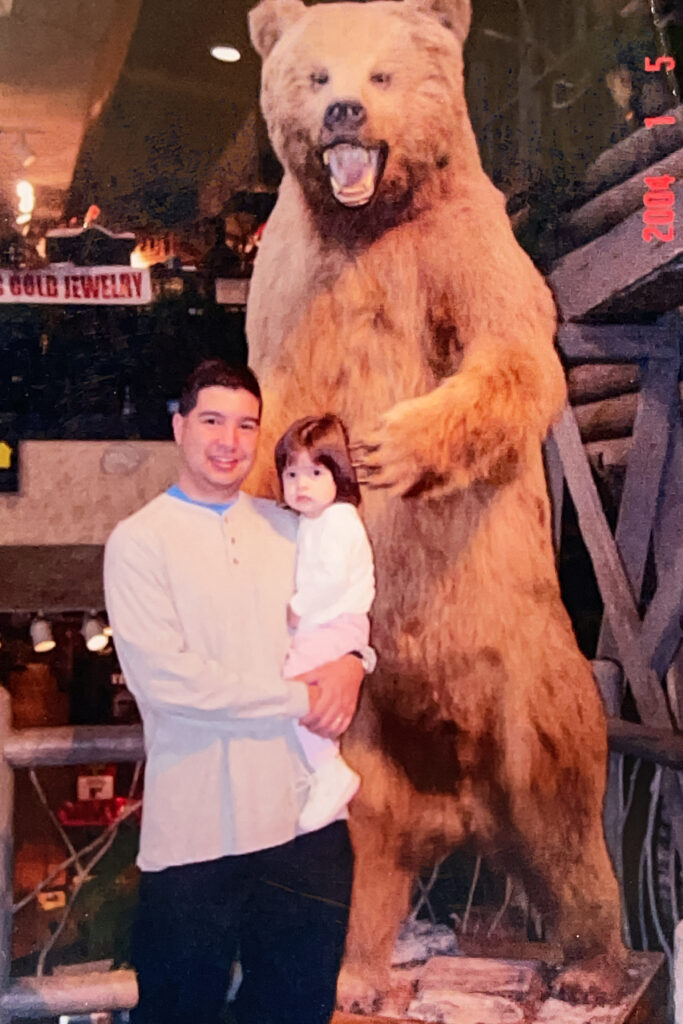I started crying as soon as we entered the store. Beady eyes stared at me from every direction. Hulking bodies bristled with dead fur. Chipped claws reached for me. My parents stared at me in bewilderment. They had no idea they’d just introduced me to a life-long phobia: taxidermy.

Like a lot of nightmares, it all started at the birthplace of Bass Pro Shops.
My mom laughs as she reminds me she still has the photo of my dad holding me in front of a mounted bear. He was smiling. My face showed a degree of fear that would make someone think I was about to be attacked by a real bear.
Since then, things have just gotten worse. As a teenager, I cried in a museum on a family trip. At age 18, I waited outside in 100-degree heat to avoid a half-circle room of taxidermy at the University of Kansas Natural History Museum. And just a few months ago, my mom coaxed me, my eyes tightly shut, out of a Scheels sporting goods store as stuffed critters loomed above us.
The thing is, according to the DSM-5, otherwise known as the Diagnostic and Statistical Manual of Mental Disorders, Fifth Edition, the fear of taxidermy isn’t a recognized phobia. Rather it would fall under the broad category of a specific phobia. Fear of spiders (arachnophobia): sure, lots of people experience that. Fear of needles (trypanophobia): understandable. Fear of heights (acrophobia): makes sense. But a fear of dead-eyed diorama bears? Nope.
But that doesn’t mean I don’t have a phobia. According to the DSM-5, specific phobias can develop on their own for various reasons. There’s a whole criterion for diagnosing these nebulous phobias, like having an unreasonable fear (check), immediate anxiety (check), intentional avoidance (check) and lasting longer than six months (definitely check).
One of the ways to deal with a phobia is exposure therapy. The bad news: it often has mixed results. But a 2020 study did examined the success of exposure therapy for a specific phobia. One of the findings was that there is a better chance of success if someone is highly motivated to overcome their fear. I’m not just motivated – I’m determined. Taxidermy seems like such a silly thing to be afraid of, especially considering I don’t have any other typical fear. Heights and bugs don’t bother me. I have no problem squeezing myself into a confined space. But a piece of taxidermy will stop me in my tracks. And I figure if I can overcome this fear that’s been an ongoing part of my life, it will give me the confidence and proof that I can overcome other anxieties in life.
My first step was to create an exposure therapy plan for myself, or as I like to call it: Julia’s Journey to Touch Taxidermy (and Not Cry).
According to the American Psychological Association, exposure therapy is designed to help an individual break the pattern of avoiding their fear and be exposed to it in real life. Exposure therapy can also be practiced at different paces. I chose to try a graded exposure approach, where you work your way up to different types of exposure to the feared stimulus. This marked the start of a four-step plan to conquer my fear.
Step One: Talk to a Taxidermist
Tiffany Scovel has been a taxidermist for around 20 years, working with mostly deer. My conversation with Scovel included my first breakthrough in understanding why people would even want a mounted animal.
“They’re generally to preserve a memory,” Scovel said. “It could be a very small deer rack and you’re like, ‘Why is that person paying the money to mount it?’ But it was with their dad and their first hunt or this person has now passed away.”
That made sense to me. I collect keychains from places that hold important memories. Other people collect stuffed squirrels dressed in tutus. Totally the same, right?
But Scovel helped me see taxidermy in a different light – one that was surprisingly artistic. She explained how once the hide of the animal is placed over a foam mannequin and dries, there’s often some shrinkage, usually around the eyes. A taxidermist then has to resculpt it with clay to make it look realistic and use paint to make it blend naturally with the animal’s hide. Scovel referred to this part of the process as the hair-and-makeup stage.
After our conversation, I felt a bit better about taxidermy. I was intrigued by the artistic side of the craft. I had taken art classes all four years of high school and spent my senior year working on mixed media pieces. I started to see the ways taxidermy could be viewed as a mixed media art piece – even if I wasn’t a fan.
Step Two: Attend a Taxidermy Convention
I spent an hour driving to the Iowa Taxidermy Association show in Tama, Iowa. The entire drive, my anxiety began to creep up. Palms sweating. Muscles tensing. I was entering flight-or-fight mode at the mere thought of getting up close and personal with taxidermy. I tried to stay calm – I needed to stay open to the process if I wanted my exposure therapy plan to work. And I really did want it to work.
At the Iowa Taxidermy Association show, I met Vicki and Tom Matuska, who run a taxidermy business. I explained what I knew about taxidermy and the aspects that caught my interest before we headed into the showroom. When I mentioned how it reminded me of a mixed media piece, she nodded.
“If you look at it as art and not as a dead animal, you’ll be okay,” Vicki said. “You know, in some art museums, sometimes you like the piece, sometimes you don’t.”
We walked around for a while, and I really did try to think about all these dead animals as just another art form. And it helped – until Vicki we came to a mounted deer head.
“Want to touch it? I mean, just go. It’s just hair – it’s soft,” Vicki said.
For a moment, I froze. I knew if I declined to touch the deer, Vicki would continue on with the tour. But at the same time, this was the chance to prove to myself that I could overcome my fear. The fear that I thought would control me forever.
With a nervous laugh, a shaking hand and the prickling of tears in my eyes, I briefly touched the mounted deer head with the tip of three fingers. She was right – it was soft.
And I survived. Without crying.
With the phantom feeling of the fur against my fingers, we continued to walk through the exhibits. I stood less than a foot away from various mounted animals, including a full-body mounted black bear. At each exhibit, Vicki took the time to explain what about the piece made it well-crafted. As time went on, I found myself feeling less nervous, even getting closer to look at the pieces.
When I got back to my car, I let out a huge breath. I’d overcome a fear that I thought would control me for the rest of my life. Don’t get me wrong – I’m not making plans to go pet more mounted deer heads any time soon, but I proved to myself that I could. It may have been the adrenaline rush, but in that moment I felt an exhilarating level of confidence.
Step Three: Get Up Close and Personal with the Process
I met Scovel at her workplace to see taxidermy at various stages in the process. I saw it all, from a deer hide with a layer of tissue still attached, to the hides soaking in the pickling process, to touching a hide that was being prepared to be put on a foam mount. I even stuck my finger in the ear of a mounted deer head to feel where she placed clay to help connect the ear liner to the rest of the foam mannequin.
I spent over an hour with Scovel learning about the taxidermy process. And for once, no tears filled my eyes. My hands didn’t shake. I wasn’t out of breath. I thought I had finally done it – I had overcome my fear.
Step Four: Returning to the Place of Nightmares
I wasn’t going back to the Bass Pro in Springfield. This time, I was visiting one located in Altoona, Iowa. But most Bass Pro Shops have one defining feature that was the pinnacle of my fears – a gigantic waterfall swarming with mounted animals.
Opening the doors to enter Bass Pro, I felt a familiar anxiety. I was walking into a store I actively avoided for the past 13 years, with no experienced taxidermist to remind me about the logic and artistry behind each piece.
I was immediately met by two huge brown animals, antlers locked in a fight. I didn’t look long enough to allow my brain to process which animals – they could have been moose or deer. My heart rate picked up. I took deep breaths and reminded myself of how far I had already come. I walked farther into the store.
I saw a brown bear mounted on its back legs standing behind a bench, and my goal became clear. This was the ultimate way to conquer my fear. I would sit on the bench and take a selfie with the bear before leaving.
I walked closer to it. A rush of fear spiked through me and I turned away. Then I repeated the process another four times – approaching slowly, only to chicken out at the last second. All the information I had learned about taxidermy, from the memory it can hold for people to the artistic process, fled my brain. I took a few deep breaths. I realized even though I was afraid, just being in the Bass Pro store by myself was a huge accomplishment. One that, a few weeks ago, I would have thought was impossible. I had already made it this far. I wasn’t going to let myself chicken out.
I walked to the bench and sat on the edge of it. I pulled out my phone with shaking hands.
I got the picture. I even managed to smile without looking too scared.
I’m never going to love taxidermy. It’s just not going to happen. But my fear is now more manageable than it has ever been. Thanks to my four-step plan, I know what to do now. As long as I take the time to look at the taxidermy, get close to it and see it for the art that it is, I’ll be okay. Though no memory will ever be important enough to put a stuffed deer head in my house. Some lines will never be crossed.

